Evaluating China’s Role in Achieving the 1.5 °C Target of the Paris Agreement
Abstract
1. Introduction
2. Methodology
3. Results
3.1. Global and China’s Emission Pathways
3.2. Global Mean Temperature Projections
3.3. Effects of China’s Emissions on the Global Mean Temperature
3.4. Effects of Emissions from Individual Gases and Aerosols on Global Mean Temperature
3.5. China’s CH4 Mitigation
4. Discussion
4.1. Significant Contribution of China’s Mitigation to the Global Efforts toward the 1.5 °C Target
4.2. Differences in the Temperature Contribution from Individual Gases
4.3. Impact of China’s CH4 Mitigation on the Global Peak Temperature
5. Conclusions
Supplementary Materials
Author Contributions
Funding
Institutional Review Board Statement
Informed Consent Statement
Data Availability Statement
Acknowledgments
Conflicts of Interest
References
- IPCC. Summary for Policymakers. In Climate Change 2022: Impacts, Adaptation, and Vulnerability. Contribution of Working Group II to the Sixth Assessment Report of the Intergovernmental Panel on Climate Change; Cambridge University Press: Cambridge, UK, 2022; In Press. [Google Scholar]
- Yokohata, T.; Tanaka, K.; Nishina, K.; Takahashi, K.; Emori, S.; Kiguchi, M.; Iseri, Y.; Honda, Y.; Okada, M.; Masaki, Y.; et al. Visualizing the Interconnections Among Climate Risks. Earths Future 2019, 7, 85–100. [Google Scholar] [CrossRef]
- UNFCCC. Adoption of the Paris Agreement; FCCC/CP/2015/L.9/Rev.1; UNFCCC: New York, NY, USA, 2015. [Google Scholar]
- IPCC. “Global Warming of 1.5 °C”, Chapter 3: Impacts of 1.5°C of Global Warming on Natural and Human Systems; IPCC Special Report; IPCC: Geneva, Sswitzerland, 2018. [Google Scholar]
- Hoegh-Guldberg, O.; Jacob, D.; Taylor, M.; Bolaños, T.G.; Bindi, M.; Brown, S.; Camilloni, I.A.; Diedhiou, A.; Djalante, R.; Ebi, K.; et al. The Human Imperative of Stabilizing Global Climate Change at 1.5 °C. Science 2019, 365, eaaw6974. [Google Scholar] [CrossRef] [PubMed]
- Li, W.; Jiang, Z.; Zhang, X.; Li, L.; Sun, Y. Additional Risk in Extreme Precipitation in China from 1.5 °C to 2.0 °C Global Warming Levels. Sci. Bull. 2018, 63, 228–234. [Google Scholar] [CrossRef]
- Su, B.; Huang, J.; Fischer, T.; Wang, Y.; Kundzewicz, Z.W.; Zhai, J.; Sun, H.; Wang, A.; Zeng, X.; Wang, G.; et al. Drought Losses in China Might Double between the 1.5 °C and 2.0 °C Warming. Proc. Natl. Acad. Sci. USA 2018, 115, 10600–10605. [Google Scholar] [CrossRef]
- IPCC. Summary for Policymakers. In Climate Change 2021: The Physical Science Basis. Contribution of Working Group I to the Sixth Assessment Report of the Intergovernmental Panel on Climate Change; Cambridge University Press: Cambridge, UK; New York, NY, USA, 2021; pp. 3–32. [Google Scholar]
- UNFCCC. Glasgow Climate Pact; FCCC/PA/CMA/2021/10/Add.1; UNFCCC: New York, NY, USA, 2022. [Google Scholar]
- Roelfsema, M.; van Soest, H.L.; Harmsen, M.; van Vuuren, D.P.; Bertram, C.; den Elzen, M.; Höhne, N.; Iacobuta, G.; Krey, V.; Kriegler, E.; et al. Taking Stock of National Climate Policies to Evaluate Implementation of the Paris Agreement. Nat. Commun. 2020, 11, 2096. [Google Scholar] [CrossRef]
- Jackson, R.B.; Le Quéré, C.; Andrew, R.M.; Canadell, J.G.; Peters, G.P.; Roy, J.; Wu, L. Warning Signs for Stabilizing Global CO2 Emissions. Environ. Res. Lett. 2017, 12, 110202. [Google Scholar] [CrossRef]
- NDRC. China’s Achievements, New Goals and New Measures for Nationally Determined Contributions. Available online: https://unfccc.int/sites/default/files/NDC/2022-06/China%E2%80%99s%20Achievements%2C%20New%20Goals%20and%20New%20Measures%20for%20Nationally%20Determined%20Contributions.pdf (accessed on 12 July 2022).
- UNFCCC. China’s Mid-Century Long-Term Low Greenhouse Gas Emission Development Strategy. Available online: https://unfccc.int/documents/307765 (accessed on 12 July 2022).
- Thomas, H.; Takeshi, K.; John, L.; Brendan, M.; Steve, S.; Ria, A.; Richard, B.; Mirte, B.; Peter, C.; Frederic, H.; et al. Net Zero Tracker. Energy and Climate Intelligence Unit, Data-Driven EnviroLab, NewClimate Institute, Oxford Net Zero. 2022. Available online: https://zerotracker.net/ (accessed on 19 August 2022).
- Zhao, X.; Ma, X.; Chen, B.; Shang, Y.; Song, M. Challenges toward Carbon Neutrality in China: Strategies and Countermeasures. Resour. Conserv. Recycl. 2022, 176, 105959. [Google Scholar] [CrossRef]
- He, J.; Li, Z.; Zhang, X.; Wang, H.; Dong, W.; Du, E.; Chang, S.; Ou, X.; Guo, S.; Tian, Z.; et al. Towards Carbon Neutrality: A Study on China’s Long-Term Low-Carbon Transition Pathways and Strategies. Environ. Sci. Ecotechnol. 2022, 9, 100134. [Google Scholar] [CrossRef]
- Rogelj, J.; den Elzen, M.; Höhne, N.; Fransen, T.; Fekete, H.; Winkler, H.; Schaeffer, R.; Sha, F.; Riahi, K.; Meinshausen, M. Paris Agreement Climate Proposals Need a Boost to Keep Warming Well below 2 °C. Nature 2016, 534, 631–639. [Google Scholar] [CrossRef]
- Wollenberg, E.; Richards, M.; Smith, P.; Havlík, P.; Obersteiner, M.; Tubiello, F.N.; Herold, M.; Gerber, P.; Carter, S.; Reisinger, A.; et al. Reducing Emissions from Agriculture to Meet the 2 °C Target. Glob. Chang. Biol. 2016, 22, 3859–3864. [Google Scholar] [CrossRef]
- Tokimatsu, K.; Wachtmeister, H.; McLellan, B.; Davidsson, S.; Murakami, S.; Höök, M.; Yasuoka, R.; Nishio, M. Energy Modeling Approach to the Global Energy-Mineral Nexus: A First Look at Metal Requirements and the 2 °C Target. Appl. Energy 2017, 207, 494–509. [Google Scholar] [CrossRef]
- Wang, H.; Chen, W. Modeling of Energy Transformation Pathways under Current Policies, NDCs and Enhanced NDCs to Achieve 2-Degree Target. Appl. Energy 2019, 250, 549–557. [Google Scholar] [CrossRef]
- Su, X.; Takahashi, K.; Fujimori, S.; Hasegawa, T.; Tanaka, K.; Kato, E.; Shiogama, H.; Masui, T.; Emori, S. Emission Pathways to Achieve 2.0°C and 1.5°C Climate Targets. Earths Future 2017, 5, 592–604. [Google Scholar] [CrossRef]
- Shi, Y.; Zhang, D.-F.; Xu, Y.; Zhou, B.-T. Changes of Heating and Cooling Degree Days over China in Response to Global Warming of 1.5 °C, 2 °C, 3 °C and 4 °C. Adv. Clim. Chang. Res. 2018, 9, 192–200. [Google Scholar] [CrossRef]
- Luderer, G.; Vrontisi, Z.; Bertram, C.; Edelenbosch, O.Y.; Pietzcker, R.C.; Rogelj, J.; Boer, H.S.D.; Drouet, L.; Emmerling, J.; Fricko, O.; et al. Residual Fossil CO2 Emissions in 1.5–2 °C Pathways. Nat. Clim. Chang. 2018, 8, 626–633. [Google Scholar] [CrossRef]
- Vrontisi, Z.; Luderer, G.; Saveyn, B.; Keramidas, K.; Lara, A.R.; Baumstark, L.; Bertram, C.; Boer, H.S.; de Drouet, L.; Fragkiadakis, K.; et al. Enhancing Global Climate Policy Ambition towards a 1.5 °C Stabilization: A Short-Term Multi-Model Assessment. Environ. Res. Lett. 2018, 13, 044039. [Google Scholar] [CrossRef]
- Tanaka, K.; O’Neill, B.C. The Paris Agreement Zero-Emissions Goal is not Always Consistent with the 1.5 °C and 2 °C Temperature Targets. Nat. Clim. Chang. 2018, 8, 319–324. [Google Scholar] [CrossRef]
- Jiang, K.; He, C.; Dai, H.; Liu, J.; Xu, X. Emission Scenario Analysis for China under the Global 1.5 °C Target. Carbon Manag. 2018, 9, 481–491. [Google Scholar] [CrossRef]
- Denison, S.; Forster, P.M.; Smith, C.J. Guidance on Emissions Metrics for Nationally Determined Contributions under the Paris Agreement. Environ. Res. Lett. 2019, 14, 124002. [Google Scholar] [CrossRef]
- Pedde, S.; Kok, K.; Hölscher, K.; Frantzeskaki, N.; Holman, I.; Dunford, R.; Smith, A.; Jäger, J. Advancing the Use of Scenarios to Understand Society’s Capacity to Achieve the 1.5 Degree Target. Glob. Environ. Chang. 2019, 56, 75–85. [Google Scholar] [CrossRef]
- Warszawski, L.; Kriegler, E.; Lenton, T.M.; Gaffney, O.; Jacob, D.; Klingenfeld, D.; Koide, R.; Costa, M.M.; Messner, D.; Nakicenovic, N.; et al. All Options, Not Silver Bullets, Needed to Limit Global Warming to 1.5 °C: A Scenario Appraisal. Environ. Res. Lett. 2021, 16, 064037. [Google Scholar] [CrossRef]
- Brutschin, E.; Pianta, S.; Tavoni, M.; Riahi, K.; Bosetti, V.; Marangoni, G.; van Ruijven, B.J. A Multidimensional Feasibility Evaluation of Low-Carbon Scenarios. Environ. Res. Lett. 2021, 16, 064069. [Google Scholar] [CrossRef]
- Duan, H.; Zhou, S.; Jiang, K.; Bertram, C.; Harmsen, M.; Kriegler, E.; van Vuuren, D.P.; Wang, S.; Fujimori, S.; Tavoni, M.; et al. Assessing China’s Efforts to Pursue the 1.5°C Warming Limit. Science 2021, 372, 378–385. [Google Scholar] [CrossRef]
- Zheng, J.; Duan, H.; Zhou, S.; Wang, S.; Gao, J.; Jiang, K.; Gao, S. Limiting Global Warming to below 1.5 °C from 2 °C: An Energy-System-Based Multi-Model Analysis for China. Energy Econ. 2021, 100, 105355. [Google Scholar] [CrossRef]
- Chen, J.; Cui, H.; Xu, Y.; Ge, Q. Long-Term Temperature and Sea-Level Rise Stabilization before and beyond 2100: Estimating the Additional Climate Mitigation Contribution from China’s Recent 2060 Carbon Neutrality Pledge. Environ. Res. Lett. 2021, 16, 074032. [Google Scholar] [CrossRef]
- Nordhaus, W.D. An Optimal Transition Path for Controlling Greenhouse Gases. Science 1992, 258, 1315–1319. [Google Scholar] [CrossRef] [PubMed]
- Duan, H.; Zhang, G.; Wang, S.; Fan, Y. Robust Climate Change Research: A Review on Multi-Model Analysis. Environ. Res. Lett. 2019, 14, 033001. [Google Scholar] [CrossRef]
- Tanaka, K.; Kriegler, E.; Bruckner, T.; Hooss, G.; Knorr, W.; Raddatz, T. Aggregated Carbon Cycle, Atmospheric Chemistry, and Climate Model (ACC2)—Description of the Forward and Inverse Modes. Retrieved from Hamburg. 2007. Available online: http://hdl.handle.net/11858/00-001M-0000-0011-FB8D-1 (accessed on 10 July 2022).
- Bruckner, T.; Hooss, G.; Füssel, H.M.; Hasselmann, K. Climate System Modeling in the Framework of the Tolerable Windows Approach: The ICLIPS Climate Model. Clim. Chang. 2003, 56, 119–137. [Google Scholar] [CrossRef]
- Hooss, G.; Voss, R.; Hasselmann, K.; Maier-Reimer, E.; Joos, F. A Nonlinear Impulse Response Model of the Coupled Carbon Cycle-Climate System (NICCS). Clim. Dyn. 2001, 18, 189–202. [Google Scholar] [CrossRef]
- Tanaka, K.; Boucher, O.; Ciais, P.; Johansson, D.J.A.; Morfeldt, J. Cost-Effective Implementation of the Paris Agreement Using Flexible Greenhouse Gas Metrics. Sci. Adv. 2021, 7, eabf9020. [Google Scholar] [CrossRef]
- Nicholls, Z.R.J.; Meinshausen, M.; Lewis, J.; Gieseke, R.; Dommenget, D.; Dorheim, K.; Fan, C.S.; Fuglestvedt, J.S.; Gasser, T.; Golüke, U.; et al. Reduced Complexity Model Intercomparison Project Phase 1: Introduction and Evaluation of Global-Mean Temperature Response. Geosci. Model Dev. 2020, 13, 5175–5190. [Google Scholar] [CrossRef]
- Kriegler, E. Imprecise Probability Analysis for Integrated Assessment of Climate Change; Universität Potsdam: Potsdam, Germany, 2005. [Google Scholar]
- IPCC. Summary for Policymakers. In Climate Change 2013: The Physical Science Basis. Contribution of Working Group I to the Fifth Assessment Report of the Intergovernmental Panel on Climate Change; Cambridge University Press: Cambridge, UK; New York, NY, USA, 2013. [Google Scholar]
- Tanaka, K.; Raddatz, T.; O’Neill, B.C.; Reick, C.H. Insufficient Forcing Uncertainty Underestimates the Risk of High Climate Sensitivity. Geophys. Res. Lett. 2009, 36, L16709. [Google Scholar] [CrossRef]
- Skeie, R.B.; Fuglestvedt, J.; Berntsen, T.; Peters, G.P.; Andrew, R.; Allen, M.; Kallbekken, S. Perspective Has a Strong Effect on the Calculation of Historical Contributions to Global Warming. Environ. Res. Lett. 2017, 12, 024022. [Google Scholar] [CrossRef][Green Version]
- UNFCCC. Report of the Conference of the Parties Serving as the Meeting of the Parties to the Paris Agreement on the Third Part of Its First Session, Held in Katowice from 2 to 15 December 2018. Addendum 2. Part Two: Action Taken by the Conference of the Parties Serving as the Meeting of the Parties to the Paris Agreement; FCCC/PA/CMA/2018/3/Add.2 2019; UNFCCC: New York, NY, USA, 2018. [Google Scholar]
- O’Neill, B.C. The Jury Is Still Out on Global Warming Potentials. Clim. Chang. 2000, 44, 427–443. [Google Scholar] [CrossRef]
- Shine, K.P. The Global Warming Potential—The Need for an Interdisciplinary Retrial. Clim. Chang. 2009, 96, 467–472. [Google Scholar] [CrossRef]
- Tanaka, K.; Peters, G.P.; Fuglestvedt, J.S. Policy Update: Multicomponent Climate Policy: Why Do Emission Metrics Matter? Carbon Manag. 2010, 1, 191–197. [Google Scholar] [CrossRef]
- IPCC. Anthropogenic and Natural Radiative Forcing. In Climate Change 2013: The Physical Science Basis. Contribution of Working Group I to the Fifth Assessment Report of the Intergovernmental Panel on Climate Change; Cambridge University Press: Cambridge, UK; New York, NY, USA, 2013; pp. 659–740. ISBN 978-1-107-05799-9. [Google Scholar]
- Allen, M.; Tanaka, K.; Macey, A.; Cain, M.; Jenkins, S.; Lynch, J.; Smith, M. Ensuring That Offsets and Other Internationally Transferred Mitigation Outcomes Contribute Effectively to Limiting Global Warming. Environ. Res. Lett. 2021, 16, 074009. [Google Scholar] [CrossRef]
- CAIT. Greenhouse Gas (GHG) Emissions Climate Watch. Available online: https://www.climatewatchdata.org/ghg-emissions (accessed on 12 January 2022).
- Crippa, M.; Guizzardi, D.; Solazzo, E.; Muntean, M.; Schaaf, E.; Monforti-Ferrario, F.; Banja, M.; Olivier, J.; Grassi, G.; Rossi, S.; et al. GHG Emissions of All World Countries. Available online: https://publications.jrc.ec.europa.eu/repository/handle/JRC126363 (accessed on 12 July 2022).
- van Soest, H.L.; den Elzen, M.G.J.; van Vuuren, D.P. Net-Zero Emission Targets for Major Emitting Countries Consistent with the Paris Agreement. Nat. Commun. 2021, 12, 2140. [Google Scholar] [CrossRef]
- Andreae, M.O.; Jones, C.D.; Cox, P.M. Strong Present-Day Aerosol Cooling Implies a Hot Future. Nature 2005, 435, 1187–1190. [Google Scholar] [CrossRef]
- Tanaka, K.; Raddatz, T. Correlation between Climate Sensitivity and Aerosol Forcing and Its Implication for the “Climate Trap”: A Letter. Clim. Chang. 2011, 109, 815–825. [Google Scholar] [CrossRef][Green Version]
- Samset, B.H.; Sand, M.; Smith, C.J.; Bauer, S.E.; Forster, P.M.; Fuglestvedt, J.S.; Osprey, S.; Schleussner, C.-F. Climate Impacts From a Removal of Anthropogenic Aerosol Emissions. Geophys. Res. Lett. 2018, 45, 1020–1029. [Google Scholar] [CrossRef]
- Prather, M.J. Lifetimes and Time Scales in Atmospheric Chemistry. Philos. Trans. R. Soc. Math. Phys. Eng. Sci. 2007, 365, 1705–1726. [Google Scholar] [CrossRef] [PubMed]
- Allen, M.R.; Peters, G.P.; Shine, K.P.; Azar, C.; Balcombe, P.; Boucher, O.; Cain, M.; Ciais, P.; Collins, W.; Forster, P.M.; et al. Indicate Separate Contributions of Long-Lived and Short-Lived Greenhouse Gases in Emission Targets. NPJ Clim. Atmos. Sci. 2022, 5, 5. [Google Scholar] [CrossRef] [PubMed]
- Fuglestvedt, J.; Rogelj, J.; Millar, R.J.; Allen, M.; Boucher, O.; Cain, M.; Forster, P.M.; Kriegler, E.; Shindell, D. Implications of Possible Interpretations of ‘Greenhouse Gas Balance’ in the Paris Agreement. Philos. Trans. R. Soc. Math. Phys. Eng. Sci. 2018, 376, 20160445. [Google Scholar] [CrossRef] [PubMed]
- UNEP. Air Pollution in Asia and the Pacific: Science-Based Solutions; UNEP: Nairobi, Kenya, 2019. [Google Scholar]
- Climate & Clean Air Coalition. Global Methane Assessment; UNEP: Nairobi, Kenya, 2021. [Google Scholar]
- Shoemaker, J.K.; Schrag, D.P.; Molina, M.J.; Ramanathan, V. What Role for Short-Lived Climate Pollutants in Mitigation Policy? Science 2013, 342, 1323–1324. [Google Scholar] [CrossRef] [PubMed]
- Harmsen, M.; van Vuuren, D.P.; Bodirsky, B.L.; Chateau, J.; Durand-Lasserve, O.; Drouet, L.; Fricko, O.; Fujimori, S.; Gernaat, D.E.H.J.; Hanaoka, T.; et al. The Role of Methane in Future Climate Strategies: Mitigation Potentials and Climate Impacts. Clim. Chang. 2020, 163, 1409–1425. [Google Scholar] [CrossRef]
- Sun, T.; Ocko, I.B.; Sturcken, E.; Hamburg, S.P. Path to Net Zero Is Critical to Climate Outcome. Sci. Rep. 2021, 11, 22173. [Google Scholar] [CrossRef]
- E.U. & U.S. Joint EU-US Press Release on the Global Methane Pledge. Available online: https://ec.europa.eu/commission/presscorner/detail/en/IP_21_4785 (accessed on 12 July 2022).
- Ocko, I.B.; Sun, T.; Shindell, D.; Oppenheimer, M.; Hristov, A.N.; Pacala, S.W.; Mauzerall, D.L.; Xu, Y.; Hamburg, S.P. Acting Rapidly to Deploy Readily Available Methane Mitigation Measures by Sector Can Immediately Slow Global Warming. Environ. Res. Lett. 2021, 16, 054042. [Google Scholar] [CrossRef]
- Höglund-Isaksson, L.; Gómez-Sanabria, A.; Klimont, Z.; Rafaj, P.; Schöpp, W. Technical Potentials and Costs for Reducing Global Anthropogenic Methane Emissions in the 2050 Timeframe—Results from the GAINS Model. Environ. Res. Commun. 2020, 2, 025004. [Google Scholar] [CrossRef]
- Tanaka, K.; O’Neill, B.C.; Rokityanskiy, D.; Obersteiner, M.; Tol, R.S.J. Evaluating Global Warming Potentials with Historical Temperature. Clim. Chang. 2009, 96, 443–466. [Google Scholar] [CrossRef]
- Wigley, T.M.L. The Relationship between Net GHG Emissions and Radiative Forcing with an Application to Article 4.1 of the Paris Agreement. Clim. Chang. 2021, 169, 13. [Google Scholar] [CrossRef]
- Khaniabadi, Y.O.; Polosa, R.; Chuturkova, R.Z.; Daryanoosh, M.; Goudarzi, G.; Borgini, A.; Tittarelli, A.; Basiri, H.; Armin, H.; Nourmoradi, H.; et al. Human Health Risk Assessment Due to Ambient PM10 and SO2 by an Air Quality Modeling Technique. Process Saf. Environ. Prot. 2017, 111, 346–354. [Google Scholar] [CrossRef]
- Shindell, D.; Kuylenstierna, J.C.I.; Vignati, E.; van Dingenen, R.; Amann, M.; Klimont, Z.; Anenberg, S.C.; Muller, N.; Janssens-Maenhout, G.; Raes, F.; et al. Simultaneously Mitigating Near-Term Climate Change and Improving Human Health and Food Security. Science 2012, 335, 183–189. [Google Scholar] [CrossRef] [PubMed]
- Tanaka, K.; Cavalett, O.; Collins, W.J.; Cherubini, F. Asserting the Climate Benefits of the Coal-to-Gas Shift across Temporal and Spatial Scales. Nat. Clim. Chang. 2019, 9, 389–396. [Google Scholar] [CrossRef]
- O’Rourke, P.R.; Smith, S.J.; Mott, A.; Ahsan, H.; McDuffie, E.E.; Crippa, M.; Klimont, Z.; McDonald, B.; Wang, S.; Nicholson, M.B.; et al. CEDS V_2021_02_05 Release Emission Data. Zenodo. 2021. Available online: https://doi.org/10.5281/zenodo.4509372 (accessed on 12 July 2022). [CrossRef]
- Melnikova, I.; Boucher, O.; Cadule, P.; Ciais, P.; Gasser, T.; Quilcaille, Y.; Shiogama, H.; Tachiiri, K.; Yokohata, T.; Tanaka, K. Carbon Cycle Response to Temperature Overshoot Beyond 2 °C: An Analysis of CMIP6 Models. Earths Future 2021, 9, 1–19. [Google Scholar] [CrossRef]
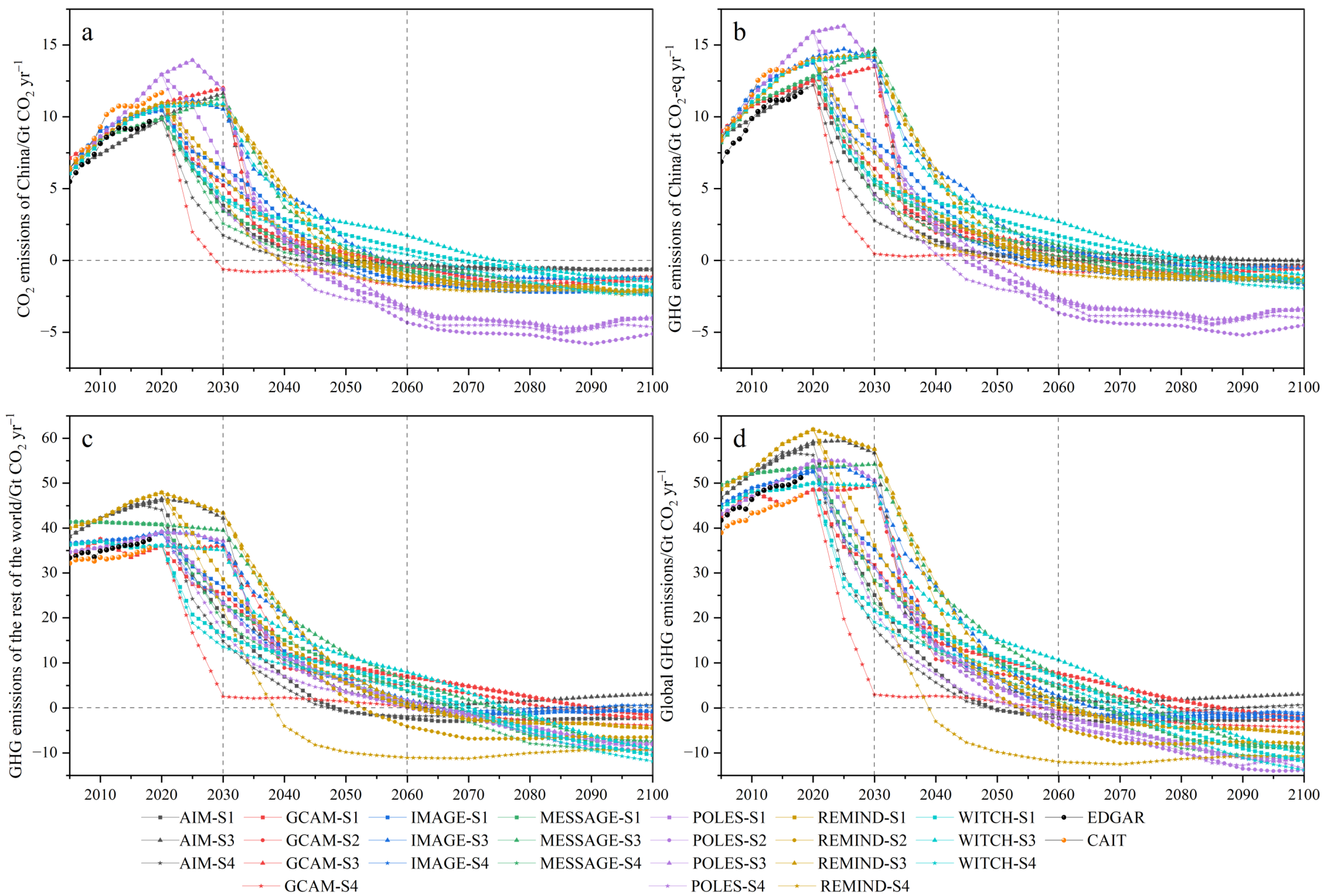
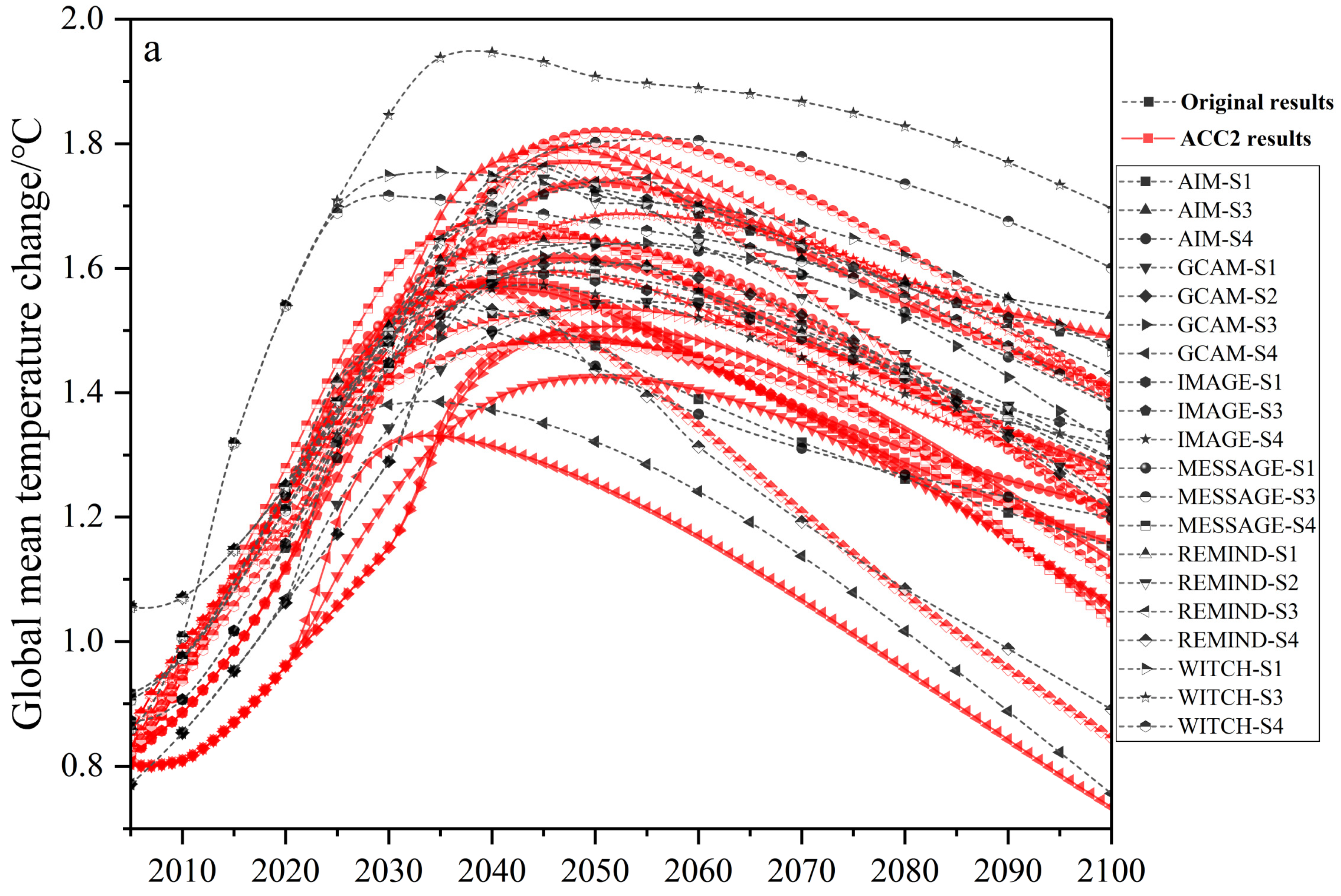
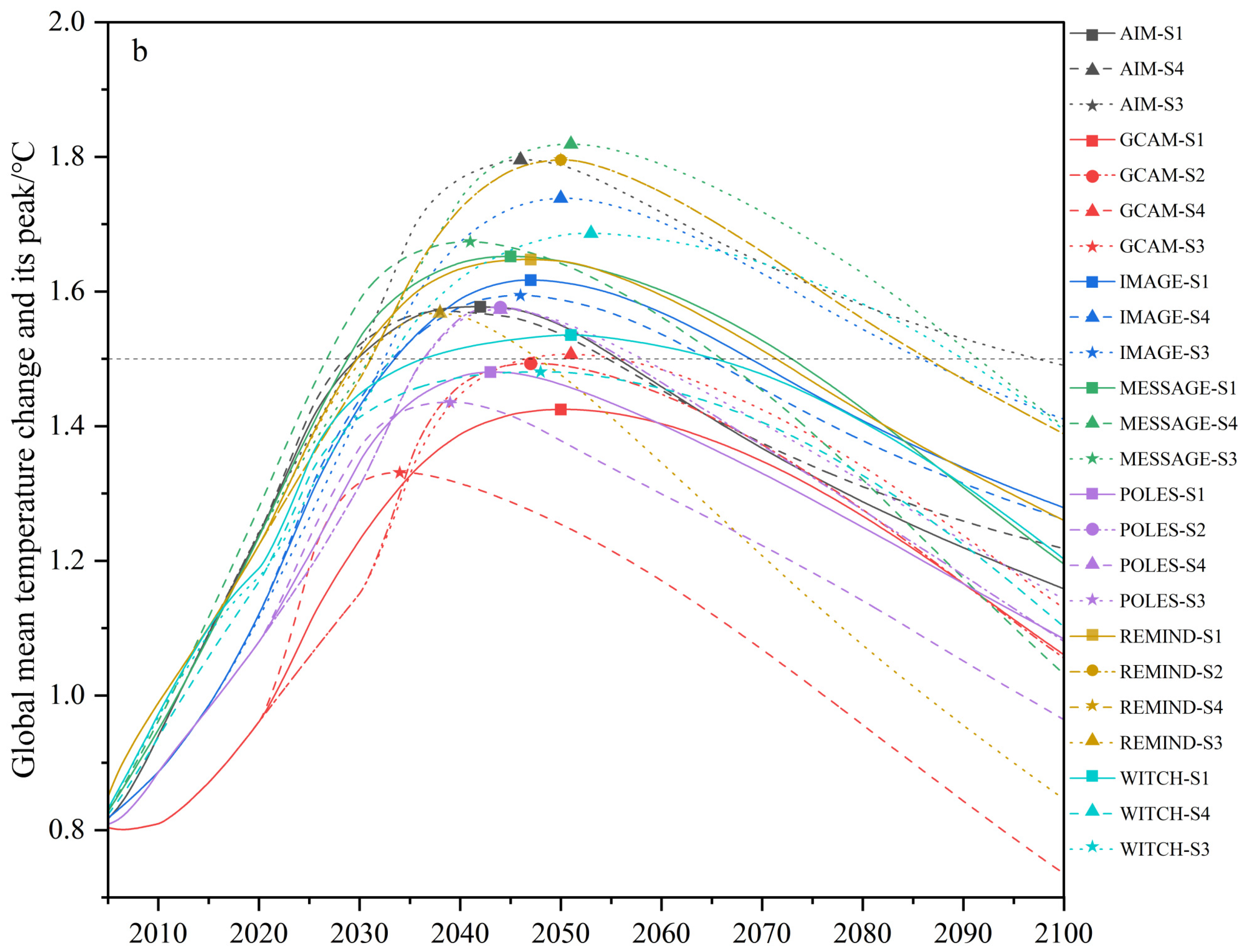
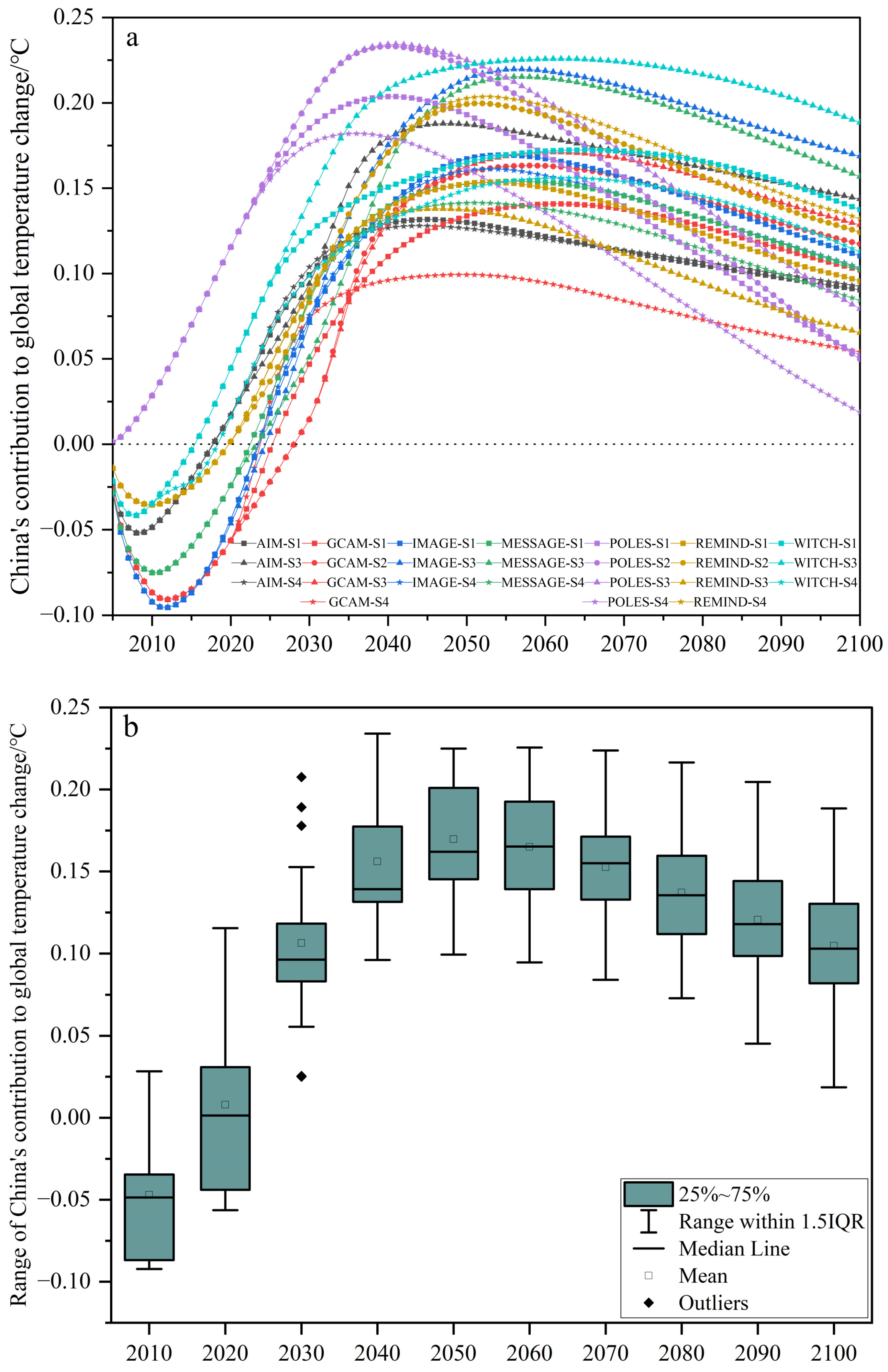
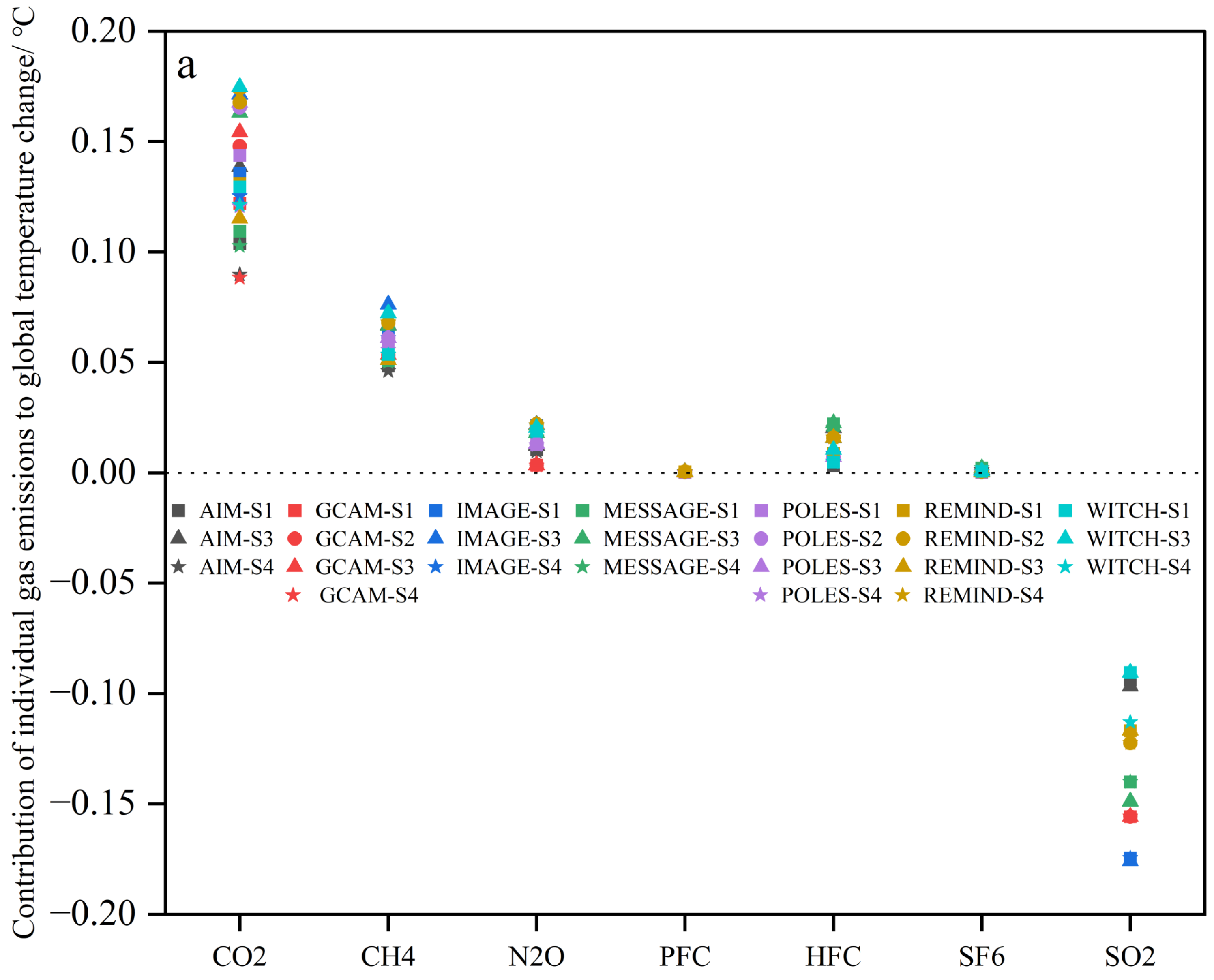
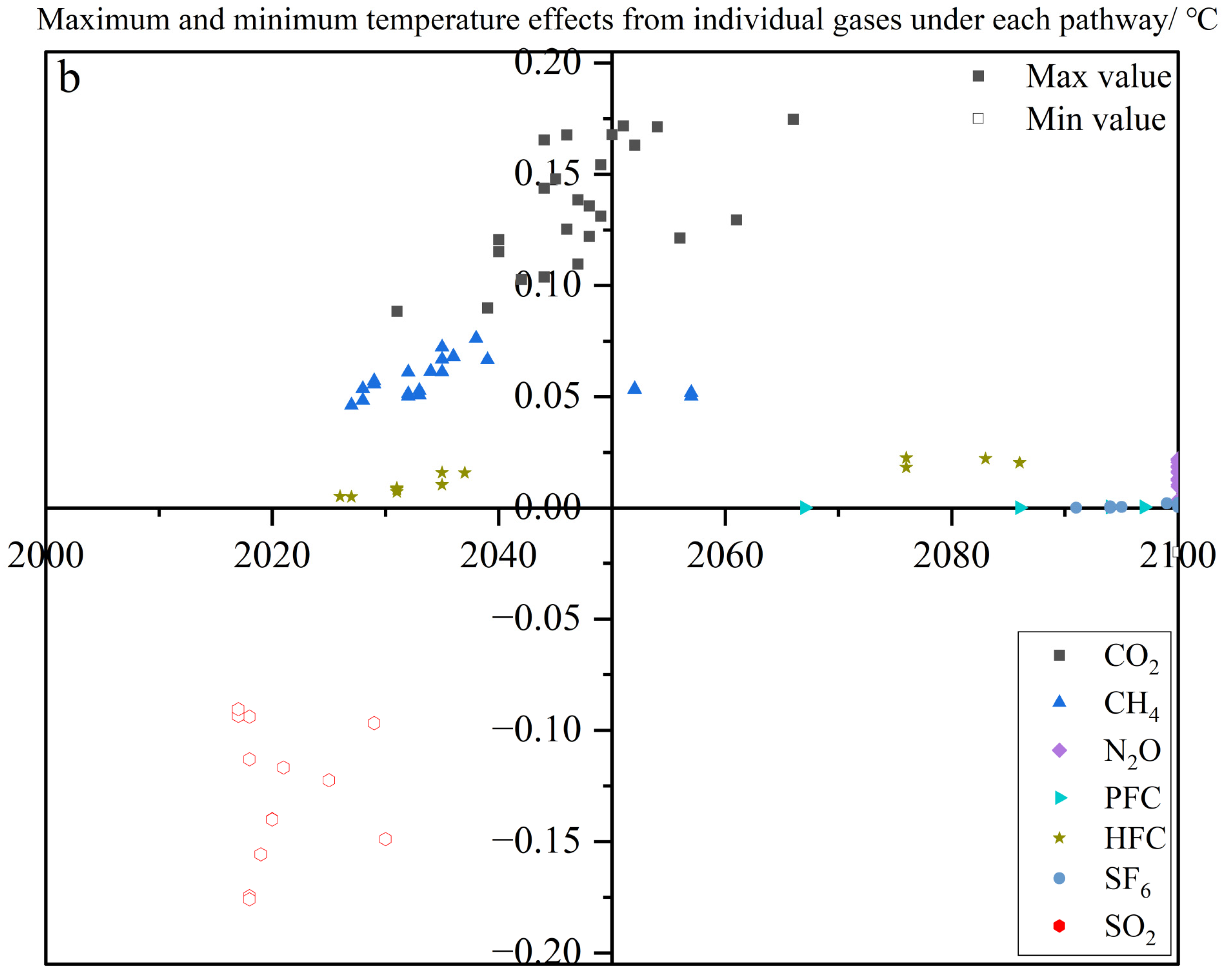
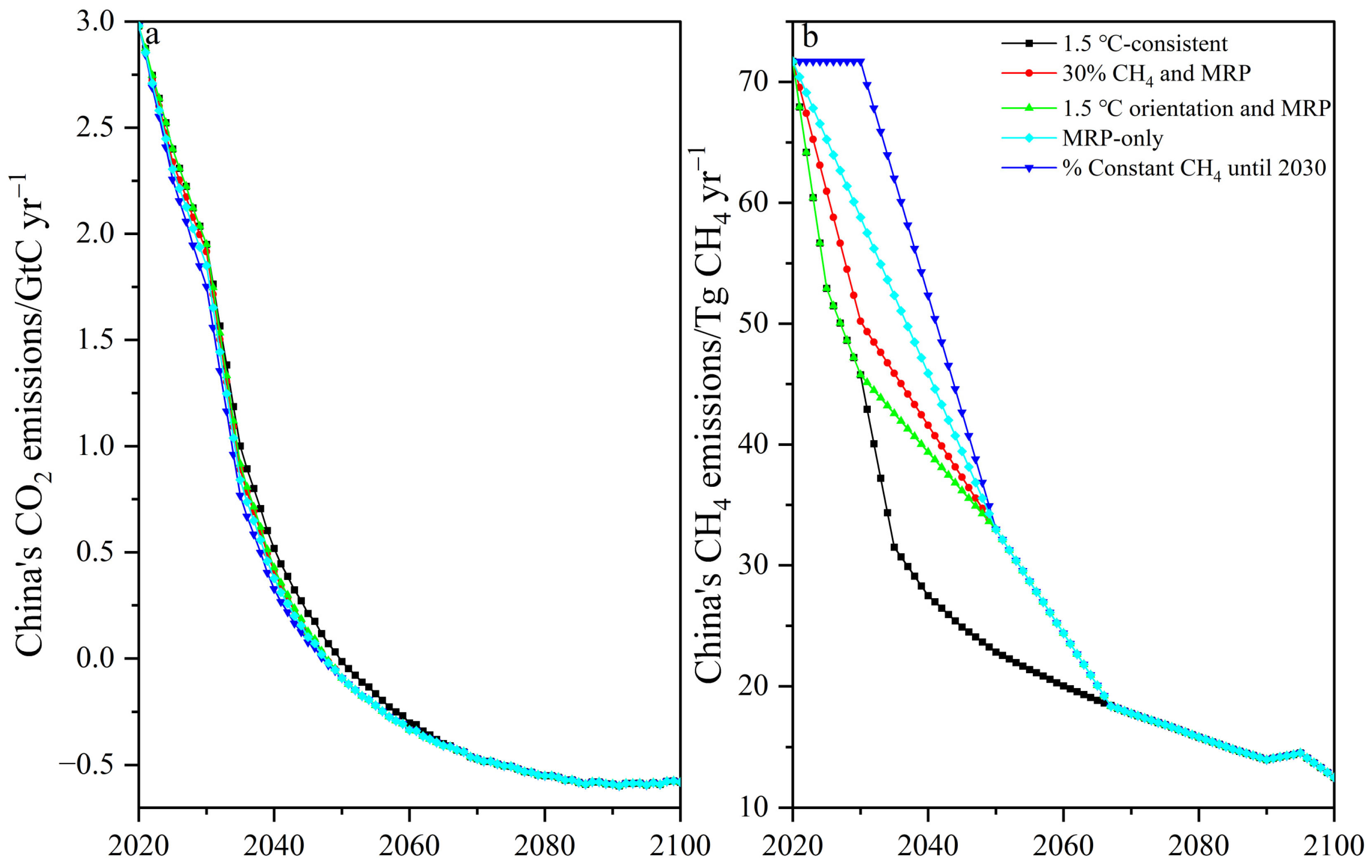
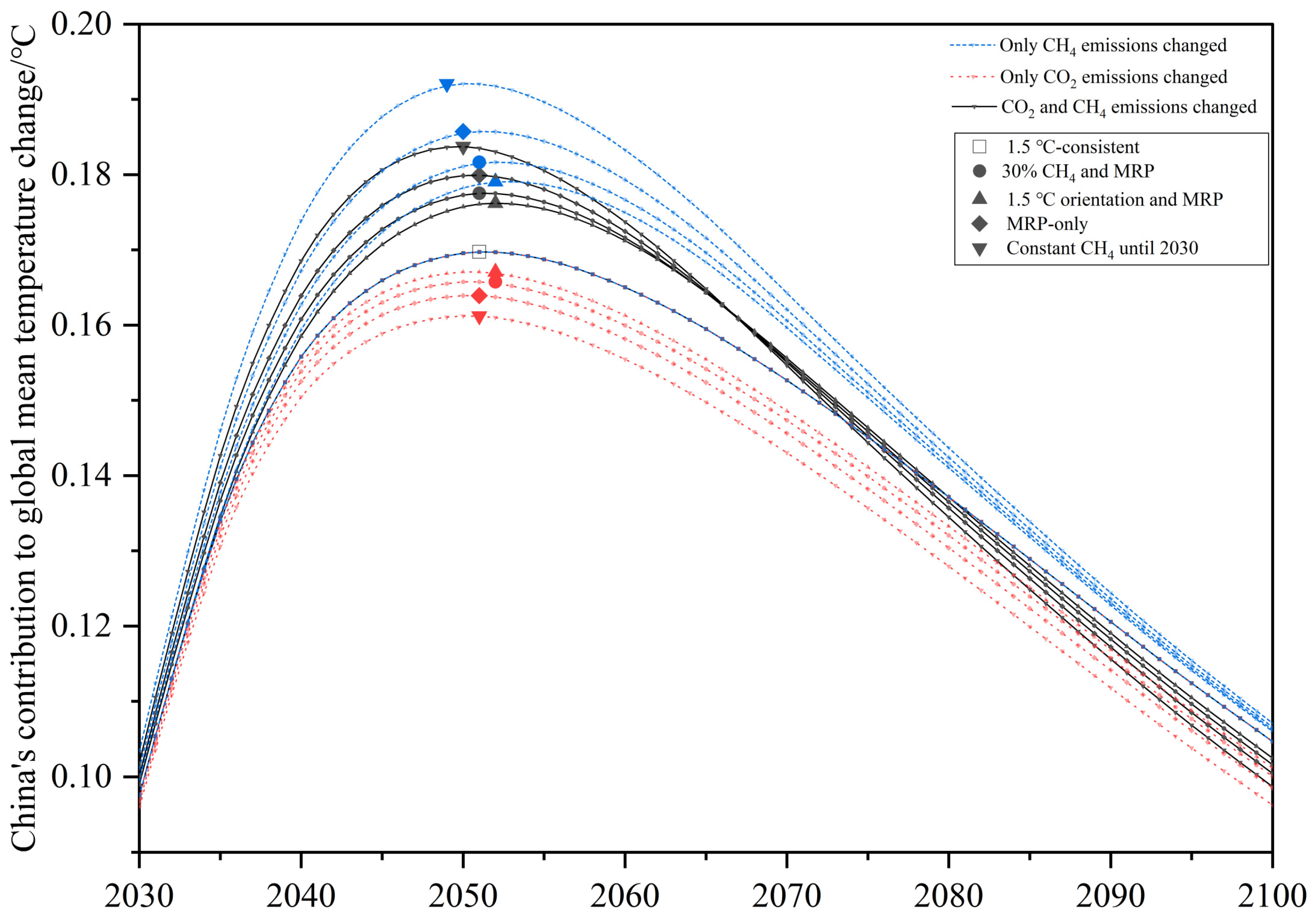
| Category | Label | Definition |
|---|---|---|
| 2020_1.5 °C-2100 | S1 | Mitigation efforts strengthened with globally uniform carbon price after 2020 to limit cumulative 2011–2100 CO2 emissions to 400 GtCO2 |
| 2030_1.5 °C-2100 | S2 | After implementing the NDCs without strengthening until 2030, the carbon budgets from the 2020_1.5 °C-2100 scenario are adopted |
| 2030_Price1.5 °C | S3 | After implementing the NDCs without strengthening until 2030, carbon price trajectories from the 2020_1.5 °C-2100 scenario are adopted |
| 2030_3xPrice1.5 °C | S4 | Implementing a 3-fold carbon price relative to the 2020_1.5 °C-2100 scenario |
| Model | Label | Source | Period | Interval | GHGs and Air Pollutants Considered for China | Reported Pathway | Climate Module |
|---|---|---|---|---|---|---|---|
| AIM/CGE V.2 | AIM | NIES, Japan Kyoto University, Japan | 2005–2100 | 5-year | CO2, CH4, N2O, CO, HFC, NOx, PFC, SF6, SO2, VOC | S1, S3, S4 | MAGICC |
| GCAM4.2_ADVANCEWP6 | GCAM | PNNL and JGCRI, USA | 2005–2100 | 5-year | CO2, CH4, N2O, SO2 | S1, S2, S3, S4 | Hector v2.0 |
| IMAGE 3.0 | IMAGE | UU, The Netherlands PBL, The Netherlands | 2005–2100 | 5-year | CO2, CH4, N2O, CO, HFC, NOx, PFC, SF6, SO2, VOC | S1, S3, S4 | MAGICC |
| MESSAGE-GLOBIOM_1.0 | MESSAGE | IIASA, Austria | 2005–2100 | 10-year | CO2, CH4, N2O, CO, HFC, NOx, SF6, SO2, VOC | S1, S3, S4 | MAGICC |
| POLES ADVANCE | POLES | EC-JRC, Belgium | 2005–2100 | 5-year | CO2, CH4, N2O, HFC, PFC, SF6 | S1, S2, S3, S4 | MAGICC |
| REMIND V1.7 | REMIND | PIK, Germany | 2005–2100 | Before 2050: 5-year After 2050: 10-year | CO2, CH4, N2O, HFC, NOx, PFC, SF6, SO2 | S1, S2, S3, S4 | MAGICC |
| WITCH | WITCH | RFF-CMCC EIEE, Italy | 2005–2100 | 5-year | CO2, CH4, N2O, CO, HFC, NOx, PFC, SF6, SO2, VOC | S1, S3, S4 | MAGICC/Internal climate module |
| Scenario | Definition |
|---|---|
| 1.5 °C-consistent | Following the average emission pathway obtained from the pathways aiming at the 1.5 °C target discussed earlier (Table 1) |
| 30% CH4 and MRP | Reducing CH4 emissions by 30% by 2030 relative to 2020 levels and then following the MRP until 2050 |
| 1.5 °C-consistent and MRP | Keeping CH4 emissions consistent with that of the 1.5 °C-consistent pathway before 2030 and then aiming toward the MRP target by 2050 |
| MRP-only | Mitigating CH4 emissions towards the 2050 MRP target after 2020, without considering the 2030 pledge of 30% CH4 reductions. |
| Constant CH4 until 2030 | Keeping CH4 emissions in line with 2020 levels before 2030 and then mitigating CH4 emissions toward the MRP until 2050 |
| Scenarios | Unit | 2030 | 2050 | 2100 | ||||||
|---|---|---|---|---|---|---|---|---|---|---|
| Both Gases | CO2-Only | CH4-Only | Both Gases | CO2-Only | CH4-Only | Both Gases | CO2-Only | CH4-Only | ||
| 1.5 °C-consistent | °C | 0.097 | 0.170 | 0.105 | ||||||
| 30% CH4 and MRP | % | 1.53 | −0.55 | 2.08 | 4.55 | −2.26 | 6.81 | −2.93 | −4.42 | 1.50 |
| 1.5 °C orientation and MRP | % | 0.00 | 0.00 | 0.00 | 3.64 | −1.47 | 5.11 | −2.10 | −3.36 | 1.27 |
| MRP-only | % | 2.69 | −0.95 | 3.65 | 6.07 | −3.33 | 9.4 | −4.04 | −5.87 | 1.83 |
| Constant CH4 until 2030 | % | 4.43 | −1.57 | 6.01 | 8.35 | −4.93 | 13.27 | −5.71 | −8.05 | 2.33 |
Publisher’s Note: MDPI stays neutral with regard to jurisdictional claims in published maps and institutional affiliations. |
© 2022 by the authors. Licensee MDPI, Basel, Switzerland. This article is an open access article distributed under the terms and conditions of the Creative Commons Attribution (CC BY) license (https://creativecommons.org/licenses/by/4.0/).
Share and Cite
Xiong, W.; Tanaka, K.; Ciais, P.; Yan, L. Evaluating China’s Role in Achieving the 1.5 °C Target of the Paris Agreement. Energies 2022, 15, 6002. https://doi.org/10.3390/en15166002
Xiong W, Tanaka K, Ciais P, Yan L. Evaluating China’s Role in Achieving the 1.5 °C Target of the Paris Agreement. Energies. 2022; 15(16):6002. https://doi.org/10.3390/en15166002
Chicago/Turabian StyleXiong, Weiwei, Katsumasa Tanaka, Philippe Ciais, and Liang Yan. 2022. "Evaluating China’s Role in Achieving the 1.5 °C Target of the Paris Agreement" Energies 15, no. 16: 6002. https://doi.org/10.3390/en15166002
APA StyleXiong, W., Tanaka, K., Ciais, P., & Yan, L. (2022). Evaluating China’s Role in Achieving the 1.5 °C Target of the Paris Agreement. Energies, 15(16), 6002. https://doi.org/10.3390/en15166002






